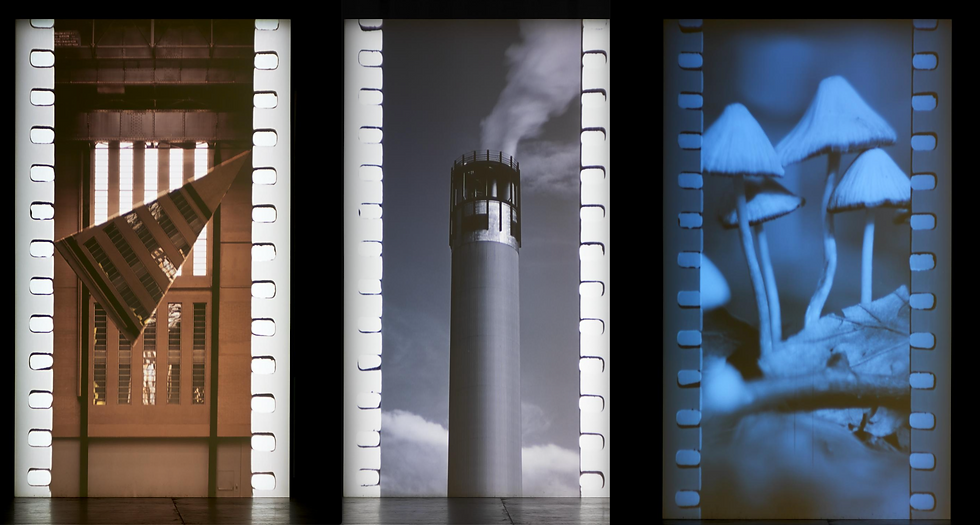Tacita Dean, 'Berlin Project' (2002) and 'Film' (2011)
- Gitanjali Bhatt
- Mar 27, 2021
- 4 min read

Tacita Dean, Berlin Project, 2002
"Berlin Project, a mystically autobiographical work for radio, was commissioned by BBC Radio 3, to Tacita Dean and broadcast as a “Between the Ears’ programme on BBC Radio 3 in 2002
Dean's audio artwork Berlin Project is constructed out of a variety of sound recordings and created sound artefacts including street sounds recorded live in Berlin and in Portugal specially created sound effects, some spoken word, and brass band music, all combining to produce an audio portrait of Berlin. She worked with producer Roger Elsgood and sound designer John Hunt to make her first wok for radio.
The Vinyl edition is the denomination of an artist’s book.
Sleeves and sleeve notes designed by Martyn Ridgewell.
Limited edition of 500 copies."
Excerpt taken from https://loja.serralves.pt/gb/inicio/6717-tacita-dean-berlin-project-2020.html Accessed 27/03/21

Tacita Dean, FILM, 2011, stills
"FILM 2011 is a portrait of the analogue, photochemical, non-digital medium of film, made by the artist Tacita Dean. It is silent, lasts 10 minutes and 42 seconds, and is played on a continuous loop. Dean made FILM by turning a Cinemascope lens ninety degrees, upending the usual landscape format so it becomes vertical and in scale with the proportions of Tate Modern’s Turbine Hall, for which the work was commissioned in 2011 as part of the Unilever Series. It has been produced in an edition of four, of which Tate’s copy is number one. FILM depicts Tate Modern, however many of the scenes are overlaid with scratches and paint or oversaturated with colour. It has sprocket holes evocative of the analogue medium down the left- and right-hand sides. When the work was shown as part of the Unilever Series in 2011–12, it was projected on a specially made screen on the eastern wall of the Turbine Hall. To produce the various visual effects in FILM Dean used both in-camera and studio techniques, such as masking, double-exposure and glass matte painting. Dean’s edit of the material, as well as her additions and manipulations, established a relationship between the artist’s hand and the mechanically produced film. The effect is playful and intimate, reminding us of the pro-filmic event – the real situation happening in front of the camera – even when projected on a monumental scale. The ad-hoc nature of the images also points to the early days of cinema, even though the film used was some of the last to be produced at the Kodak factory and so might also be seen as a lament for a nearly extinct process. In the press release for the display of FILM at Tate Modern, Dean commented that the work aimed, ‘to show film as film can be – film in its purest form’ (‘The Unilever Series 2011: Tacita Dean’, press release, Tate, 10 October 2011, http://www.tate.org.uk/press/press-releases/unilever-series-2011-tacita-dean, accessed 25 June 2018). Critic Adrian Searle, writing in the Guardian newspaper, described it as: ‘A silent movie, Film is a rejoinder to the digital noise of the modern world. It recalls early cinema and experiments with colour, cinema as art abstraction and as home movie, structuralist film and underground cinema. It is cool and passionate, lovely and weirdly old-fashioned.’ (Adrian Searle, ‘Tacita Dean: Film – Review, Guardian, 10 October 2011, https://www.theguardian.com/artanddesign/2011/oct/10/tacita-dean-film-review, accessed 25 June 2018.)
"As FILM was projected on a screen in the Turbine Hall, the architecture of Tate Modern became an integral element of the work. The steel beams which clad the walls also structured the composition of the various montage shots, while the long and narrow series of windows on the far wall recalled the strips of film, offering the viewer a complex interweaving of film and setting, real and artificial world. More broadly, like the fate of Sir Giles Gilbert Scott’s disused power station – an obsolete structure that found a new lease of life as a museum – Dean’s film reflected the fate imposed upon the medium of film as it migrates from the cinema to find its last refuge within the gallery’s walls. FILM has the rhythm and metre of a visual poem. Images, some familiar from Dean’s previous works, such as lightning, trees and seascapes, are juxtaposed with panels of colour and interact with the grid structure of the wall. The resulting piece is a montage of black and white, colour and hand-tinted images, which includes allusions to surrealist art, a painting by Dutch modernist Piet Mondrian, the mountains of René Daumal’s novel Mount Analogue and the mountain logo of Paramount Studios. Dean’s characteristic celebration of what is normally considered waste in filmmaking, such as the picture fading at the tail end of a roll, flash frames of over-exposure as the camera stops and starts, and the shimmering metamorphosis of a colour filter change, are also evident in this work. Although she works across a wide range of media, Dean has used film throughout her career – it is her working material, and she has stated that she needs ‘the stuff of film as a painter needs the stuff of paint’ (quoted in Charles Darwent, ‘Tacita Dean, Turbine Hall, Tate Modern, London’, Independent, 16 October 2011, https://www.independent.co.uk/arts-entertainment/art/reviews/tacita-dean-turbine-hall-tate-modern-london-2371148.html, accessed 25 June 2018)."
Excerpt taken from the Tate's website ------ https://www.tate.org.uk/art/artworks/dean-film-t14273 Accessed 27/03/21
Further reading: Nicholas Cullinan (ed.), Tacita Dean: FILM, exhibition catalogue, Tate Modern, London 2011. Nicholas Cullinan November 2011
Further links:


Comments